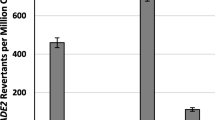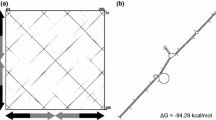Summary
Nuclear protein extracts from Mu-active, Mu-inactive and non-Mutator lines of maize were used to identify the binding sites for maize nuclear proteins in the terminal inverted repeats (TIR) of the Mul transposable element. We found binding activities of nuclear proteins that specifically interact with both TIRs of the Mu1 element. DNase I footprinting was performed to localize the binding sites. We found that the nuclear proteins from Mu-active lines and non-Mu lines bound to the Mu1 TIR at two different sites, i.e. a 13 by sequence (CGGGAACGGTAAA, designated as site I) and another 8 by sequence (CGGCGTCT, designated as site II). However, the nuclear proteins from Mu-inactive lines bound only one of these sites, i.e. site I. Mobility shift assays with synthetic oligonucleotides containing site I and 11 respectively confirmed the specificities of these binding activities. Site I was shown to be an imperfect direct repeat of a hexamer binding site (CGGGAA CGGTAA). Oligonucleotides containing either of the hexamers showed specific binding activity to nuclear protein from both Mu-active and Mu-inactive lines. The possible role of these proteins in Mu transposition is discussed.
Similar content being viewed by others
References
Barkan A, Martienssen RA (1991) Suppression of Mu induced mutations by the activation of outward transcription from the end of Mul. Proc Nail Acad Sci USA, in press
Bennetzen JL (1987) Covalent DNA modification and the regulation of Mutator element transposition in maize. Mol Gen Genet 208:45–51
Bennetzen JL, Swanson J, Taylor WC, Freeling M (1984) DNA insertion in the first intron of maize Adhl affects message levels: cloning of mutant and progenitor alleles. Proc Natl Acad Sci USA 81:4125–4128
Bennetzen JL, Fracasso RP, Morris DW, Robertson D, SkogenHagenson MJ (1987) Concomitant regulation of Mul transposition and Mutator activity in maize. Mol Gen Genet 208:57–62
Berg DE (1989) Transposon Tn5. In: Berg DE, Howe MM (eds) Mobile DNA. American Society for Microbiology, Washington DC, pp 185–210
Chandler VL, Walbot V (1986) DNA modification of a maize transposable element correlates with loss of activity. Proc Natl Acad Sci USA 83:1767–1771
Chandler V, Rivin C, Walbot V (1986) Stable non-Mutator stocks of maize have sequences homologous to Mul transposable element. Genetics 114:1007–1021
Chandler VL, Talbert LE, Mann L, Faber C (1988) Structure and DNA modification of endogenous Mu elements. In: Nelson OE (ed) Plant transposable elements. Plenum Press, New York, pp 339–350
Chen CH, Oishi KK, Kloeckener-Gruissem B, Freeling M (1987) Organ-specific expression of maize Adh1 is altered after a Mu transposon insertion. Genetics 116:469–477
Colasanti J, Sundaresan V (1991) Cytosine methylated DNA synthesized by Taq polymerase used to assay methylation sensitivity of Hinfl. Nucleic Acids Res 19:391–394
Coupland G, Baker B, Schell J, Starlinger P (1988) Characterization of the maize transposable element Ac by internal deletions. EMBO J 7:3653–3659
Coupland G, Plum C, Chaterjee S, Post A, Starlinger P (1989) Sequences near the termini are required for transposition of the maize transposable element Ac in transgenic tobacco plants. Proc Natl Acad Sci USA 86:9385–9388
Craig NL, Nash HA (1984) E. coli integration host factor binds to specific sites in DNA. Cell 39:707–716
Craigie R, Mizuuchi M, Mizuuchi K (1984) Site-specific recognition of the bacteriophage Mu ends by the Mu A protein. Cell 39:387–394
Craigie R, Arndt-Jovin DJ, Mizuuchi K (1985) A defined system for the DNA strand transfer reaction at the initiation site of bacteriophage Mu transposition: protein and DNA substrate requirements. Proc Natl Acad Sci USA 82:7570–7574
Cuypers H, Dash S, Peterson PA, Saedler H, Gierl A (1988) The defective En-1 102 element encodes a product reducing the mutability of the En/Spm transposable element system of Zea mays. EMBO J 7:2953–2960
Finnegan EJ, Taylor BH, Dennis ES, Peacock WJ (1988) Transcription of the maize transposable element Ac in maize seedling and in transgenic tobacco. Mol Gen Genet 212:505–509
Freeling M (1988) Mutagenesis using Robertson's Mutator lines and consequent insertions at the Adh1 gene in maize. In: Nelson OE (ed) Plant transposable elements. Plenum Press, New York, pp 279–288
Frey M, Reinecke J, Grant S, Saedler H, Gierl A (1990) Excision of the En/Spm transposable element of Zea mays requires two element-encoded proteins. EMBO J 9:4037–4044
Gierl A, Lutticke S, Saedler H (1988) TnpA product encoded by the transposable element En-1 of Zea mays is a DNA binding protein. EMBO J 7:4045–4053
Green PJ, Kay SA, Chua NH (1987) Sequence-specific interactions of a pea nuclear factor with light-responsive elements upstream of the rbcS-3A gene. EMBO J 6:2543–2549
Ichikawa H, Ikeda K, Wishart W, Ohtsubo E (1987) Specific binding of transposase to terminal inverted repeats of transposable element Tn3. Proc Natl Acad Sci USA 84:8220–8224
Kaufman PD, Doll RF, Rio DC (1989) Drosophila P element transposase recognizes internal P element DNA sequences. Cell 59:359–371
Kleckner N (1989) Transposon Tn10. In: Berg DE, Howe MM (eds) Mobile DNA. American Society for Microbiology, Washington DC, pp 227–268
Krebs MP, Reznikoff WS (1988) Use of a Tn5 derivative that creates lacZ translational fusions to obtain a transposition mutant. Gene 63:277–285
Kunze R, Starlinger P (1989) The putative transposase of transposable element Ac from Zea mays L. interacts with subterminal sequences of Ac. EMBO J 8:3177–3185
Kunze R, Stochaj U, Laufs J, Starlinger P (1987) Transcription of transposable element Activator (Ac) of Zea mays L. EMBO J 6:1555–1563
Lillis M, Spielmann A, Simpson RB (1985) Transfer of a Robertson's Mutator element to tomato and tobacco cells. In: Freeling M (ed) Plant genetics. Alan R. Liss, New York, pp 213–224
Makris JC, Nordmann PL, Reznikoff WS (1988) Mutational analysis of insertion sequence 50 (IS50) and transposon 5 (Tn5) ends. Proc Natl Acad Sci USA 85:2224–2228
Martienssen RA, Barkan A, Freeling M, Taylor WC (1989) Molecular cloning of a nuclear gene in maize involved in thylakoid organization, and its regulation by Robertson's mutator. EMBO J 8:1633–1640
Martienssen RA, Barkan A, Taylor WC, Freeling M (1990) Somatically heritable switches in DNA modification of Mul transposable elements in maize revealed by a suppressible mutant. Genes Dev 4:331–343
Masson P, Rutherford G, Banks JA, Fedoroff N (1989) Essential large transcripts of the maize Spin transposable element are generated by alternative splicing. Cell 58:755–765
Maxam AM, Gilbert W (1980) Sequencing end-labeled DNA with base-specific chemical cleavages. Methods Enzymol 65:499–560
McLaughlin M, Walbot V (1987) Cloning of a Mutable bz2 allele of maize by transposon tagging and differential hybridization. Genetics 117:771–776
Morisato D, Kleckner N (1987) Tn10 transposition and circle formation in vitro. Cell 51:101–111
Oishi KK, Freeling M (1988) A new Mu element from a Robertson's Mutator line. In: Nelson OE (ed) Plant transposable elements. Plenum Press, New York, pp 289–291
O'Reilly C, Shepherd NS, Pereira A, Schwarz-Sommer Zs, Bertram I, Robertson DS, Peterson PA, Saedler H (1985) Molecular cloning of the α1 locus of Zea mays using the transposable elements En and Mul. EMBO J 4:877–882
Pato ML (1989) Bacteriophage Mu. In: Berg DE, Howe MM (eds) Mobile DNA. American Society for Microbiology, Washington DC, pp 23–52
Pereira A, Cuypers H, Gierl A, Schwarz-Sommer Z, Saedler H (1986) Molecular analysis of the En/Spm transposable element system of Zea mays. EMBO J 5:835–841
Phadnis SH, Berg DE (1987) Identification of base pairs in the IS50 O end needed for IS50 and Tn5 transposition. Proc Nail Acad Sci USA 84:9118–9122
Qin M, Ellingboe AH (1990) A transcript identified by MuA of maize is associated with Mutator activity. Mol Gen Genet 224:357–363
Revzin A (1989) Gel electrophoresis assays for DNA-protein interactions. BioTechniques 7:346–355
Rio DC, Rubin GM (1988) Identification and purification of a Drosophila protein that binds to the 31 base pair inverted repeats of the transposable element. Proc Natl Acad Sci USA 85:8929–8933
Robertson DS (1978) Characterization of a imitator system in maize. Mutat Res 51:21–28
Robertson DS, Stinard PS, Wheeler JG, Marris DW (1985) Genetic and molecular studies on germinal and somatic mutability in Mutator-induced aleurone mutants of maize. In: Freeling M (ed) Plant genetics. Alan R. Liss, New York, pp 317–331
Sambrook J, Fritsch EF, Maniatis T (1989) Molecular cloning, A laboratory manual, second edition. Nolan C (ed) Cold Spring Harbor Laboratory Press, Cold Spring Harbor, NY, pp 6.36–6.37
Schnable PS, Peterson PA, Saedler H (1989) The bz-rcy allele of the Cy transposable system of Zea mays contains a Mu-like element insertion. Mol Gen Genet 217:459–463
Singh H, Sen R, Baltimore D, Sharp PA (1986) A nuclear factor that binds to a conserved sequence motif in transcriptional control elements of immunoglobulin genes. Nature 319:154–158
Sturm R, Baumruker T, Franza BR Jr, Herr W (1987) A 100-KD Hela cell octamer binding protein (OBP 100) interacts differently with two separate octamer-related sequences within the SV40 enhancer. Genes Dev 1:1147–1160
Sundaresan V, Freeling M (1987) An extrachromosomal form of the Mu transposons of maize. Proc Nail Acad Sci USA 84:4924–4928
Talbert LE, Turks D, Faber C, Mann L, Sylvester K, Raymond F, Chandler VL (1987) Molecular genetic analysis of sequences homologous to Mutator transposable elements in non-Mutatormaize stocks. In: Wettstein D von, Chua NH (eds) Plant molecular biology. Plenum Press, New York, pp 181–189
Talbert LE, Peteerson GI, Chandler VL (1989) Mu transposable elements are structurally diverse and distributed throughout the genus Zea. J Mol Evol 29:28–39
Taylor LP, Walbot V (1987) Isolation and characterization of a 1.7 kb transposable element from a Mutator line of maize. Genetics 117:297–307
Taylor LP, Chandler VL, Walbot V (1986) Insertion of 1.4 kb and 1.7 kb Mu elements into the Bronzel gene of Zea mays. Maydica 31:31–45
Vinson CR, LaMarco KL, Johnson PF, Landschulz WH, McKnight SL (1988) In situ detection of sequence-specific DNA binding activity specified by a recombinant bacteriophage. Genes Dev 2:801–806
Walbot V (1986) Inheritance of mutatory activity in Zea mays as assayed by somatic instability of bz2-mu1 allele. Genetics 114:1293–1312
Walbot V, Britt AB, Luehrsen K, McLaughlin M, Warrem C (1988) Regulation of imitator activities in maize. In: Nelson OE (ed) Plant transposable elements. Plenum Press, New York, pp 121–135
Wiater LA, Grindley NDF (1988) γδ transposase and integration host factor bind cooperatively at both γδ. EMBO J 7:1907–1911
Yin JCP, Reznikoff WS (1987) dnaA, an essential host gene, and Tn5 transposition. J Bacteriol 169:4637–4645
Author information
Authors and Affiliations
Additional information
Communicated by H. Saedler
Rights and permissions
About this article
Cite this article
Zhao, ZY., Sundaresan, V. Binding sites for maize nuclear proteins in the terminal inverted repeats of the Mul transposable element. Molec. Gen. Genet. 229, 17–26 (1991). https://doi.org/10.1007/BF00264208
Received:
Issue Date:
DOI: https://doi.org/10.1007/BF00264208




